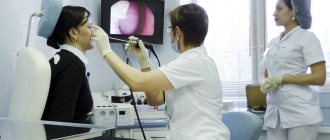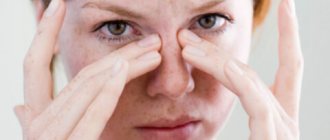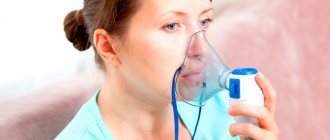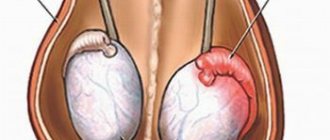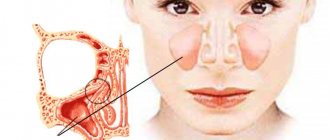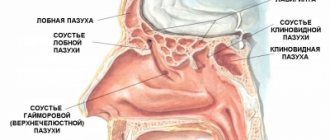The ENT organs, being an outpost of the immune system on the path of infection into the body, are the first to encounter the effects of various pathogens. That is why inflammatory processes often begin in them. Inflammation of the paranasal sinuses is called sinusitis. In total, a person has 4 pairs of paranasal sinuses, these are cavities filled with air. As a result of inflammatory processes, pus is formed in the sinuses, and the person begins to feel weak and unwell.
1
Nasal endoscopy in MedicCity
2 Nasal endoscopy in MedicCity
3 Rhinoscopy in MedicCity
Symptoms of sinusitis
There are acute and chronic forms of sinusitis, which differ in their symptoms.
Acute sinusitis. Symptoms:
- Runny nose lasting more than 7-10 days, without signs of improvement;
- nasal congestion, mucous or purulent discharge from the nose;
- mucus running down the back of the throat, copious discharge of purulent sputum in the morning;
- headache, heaviness and pain in the inflamed sinus area. Sometimes pain in the teeth, eyes, cheekbones, cheeks;
- increased sensitivity of the facial skin in the projection of the affected sinus;
- increase in body temperature (up to 38°C and above). As a rule, this symptom is observed in an acute case. In a chronic process, body temperature rarely rises or remains at subfebrile levels (37-37.50°C);
- weakness, fatigue, irritability. Photophobia, lacrimation, loss of appetite, sleep disturbance;
- weakened or absent sense of smell;
- swelling of the cheeks and eyelids.
Chronic sinusitis. Symptoms:
Symptoms of chronic sinusitis depend on the form of the disease. Outside of an exacerbation, symptoms may be very mild or absent. The most common symptoms of concern are:
- nasal congestion, difficulty in nasal breathing;
- scant mucous or purulent discharge from the nose, may be in the form of drying crusts;
- constant leakage from the nose, causing cracks and abrasions at the entrance to the nose;
- mucus running down the back of the throat;
- dry throat;
- headache;
- bad breath.
As the disease worsens, symptoms characteristic of acute sinusitis may appear.
How to treat
Treatment for viral sinusitis includes a set of remedies that help get rid of a runny nose, relieve swelling of the mucous membranes and ensure regular cleaning of the sinuses. These are decongestants with vasoconstrictor action, corticosteroids, and medications based on essential oils. They all have their downsides. Vasoconstrictors are addictive and therefore their dosage and course duration are strictly limited. Oily ones, although natural, are undesirable for allergy sufferers. The situation may be complicated by additional conditions (for example, treatment of sinusitis during breastfeeding is incompatible with the use of vasoconstrictors or steroids). That is why it is better to entrust the choice of medications to a specialist whose knowledge and experience will help make optimal prescriptions. To get rid of a bacterial infection, antibiotics will have to be added to the therapeutic regimen.
Sinusitis in children
Sometimes sinusitis in children is more difficult to see than sinusitis in adults. The disease usually develops after an infection: influenza or sore throat, and is often accompanied by otitis media. The symptoms are somewhat blurred and appear weaker than in adults. Here are the main ones:
- purulent or mucous discharge from the nose;
- general weakness, malaise;
- pungent odor from the mouth.
With sinusitis in children, one side of the face is often inflamed. While sinusitis in adults is often accompanied by headaches, headaches in children are extremely rare.
Diagnostics
An otolaryngologist can diagnose sinusitis with a high probability; if it is impossible to get a consultation with a specialized specialist, you need to make an appointment with a therapist.
Diagnostic methods
Diagnosis of the disease is made using:
- anamnesis: analysis of data reported by the sick person, records from the medical history, external examination of the patient, palpation of painful areas on the face;
- studies using instrumental methods - computed and magnetic tomography, x-ray, ultrasound equipment, sinus biopsy, fiberoptic endoscopy, diaphanoscopy;
- laboratory tests: blood, nasal discharge.
A diaphanoscope, a medical instrument that “transparent” the upper jaw, can detect an anomaly in the paranasal sinuses. The end of the device tube contains a powerful light source - a very bright light bulb. In a special darkened room, the doctor inserts an instrument into the patient’s mouth, directs the light to the upper palate and looks through the “illuminated” maxillary sinuses.
Fiberoptic endoscopy is a research method in which the patient’s nasopharynx is examined through an endoscope, an optical device that allows one to examine organs with magnification. Modern endoscopes have the ability to collect tissue and nasal contents for analysis.
Biopsy - penetration into the nasal sinuses using a special needle and taking mucus for analysis directly from the site of inflammation.
Help from specialized doctors
If the diagnosis reveals signs of polypous sinusitis, the patient will have to consult an immunologist, pulmonologist and allergist to avoid possible complications: treatment is carried out only surgically. Consultation with an allergist will be necessary if allergic sinusitis is detected.
To successfully treat the odontogenic form of the disease, you will need the help of a dentist: to eliminate the main irritating factor, you will have to heal or remove the roots of the affected teeth.
Types of sinusitis
There are several types of sinusitis:
- sinusitis;
- frontal sinusitis;
- ethmoiditis;
- sphenoiditis, but the latter type of sinusitis is extremely rare and almost always together with ethmoiditis.
1 Examination of the nasal cavity in MedicCity
2 Examination of the nasal cavity in MedicCity
3 ENT unit Atmos S 31
Rinsing the nose with Aqualor solutions
In the treatment of chronic sinusitis in adults and children, preparations for the sanitation of the nasal cavity, created on the basis of natural sea water, are successfully used. Aqualor products will be especially useful in the treatment of sinusitis during pregnancy, when many medications are prohibited.
During exacerbations, hypertonic solutions are effective: they reduce tissue swelling, have an antimicrobial effect, dissolve crusts and purulent mucous plugs. For infectious sinusitis, we recommend paying attention to hypertensive Aqualor Extra Forte. It contains chamomile and aloe extracts, known for their antiseptic properties.
During remission, regular rinsing of the nose with isotonic Aqualor Soft and Aqualor Norm helps remove bacteria and allergens.
Sinusitis
Sinusitis is one of the most common types of sinusitis. This disease is accompanied by inflammation in the maxillary and maxillary cavities. During inflammation, swelling of the mucous membrane occurs, which blocks the opening from the sinus to the nasal cavity. Mucus begins to accumulate in the sinus space, pathogenic bacteria multiply, and pus appears. Inside the cavity, pressure occurs on the vessels, and the person begins to feel pressing pain at the site of accumulation of pus.
Chronic sinusitis is the result of a long inflammatory process, when a person has had sinusitis for more than 2 months. The patient develops general weakness, nasal discharge has an unpleasant odor, the sense of smell is impaired, and a night cough appears. Chronic sinusitis is characterized by inflammation of only one sinus, right or left. Pressure in the sinus can cause a deviated nasal septum.
Symptoms of sinusitis
The following symptoms are characteristic of sinusitis:
- increased body temperature;
- copious discharge, nasal congestion;
- disturbances of smell;
- weakness;
- headache radiating to the forehead, bridge of the nose, teeth;
- pain that intensifies when tilting the head and pressing on the sinus;
- constant, intense pain;
- a feeling of fullness in the forehead and cheeks, aggravated by tilting the head, coughing and sneezing;
- photophobia and lacrimation.
Signs of sinusitis
If after a flu or cold the temperature rises again, your health worsens, severe pain appears when tilting your head and when pressing on the sinuses, then you need to urgently consult an otolaryngologist. These could be manifestations of sinusitis! Sinusitis in adults is often advanced, since adults are usually in no hurry to see a doctor.
Treatment of sinusitis
Antibiotics for sinusitis are used only after a complete examination of the patient, based on the characteristics of his body and possible allergic reactions.
Antibiotics are not advisable in case of sinusitis of allergic or fungal origin. For mild sinusitis, inhalations, rinses and immunotherapy are also sufficient.
1 Rhinoscopy in MedicCity
2 Video endoscopy of the nasopharynx in MedicCity
3 ENT office in MedicCity
Causes of occurrence
The maxillary sinuses are a natural barrier against infections, pathogens and other negative factors that are in the air. Therefore, the main cause of sinusitis is the contact of infections, allergens, and fungi on the mucous membrane. Inflammatory agents can enter the maxillary sinuses through the blood.
A weakening of the human immune system can worsen the functioning of the mucous membranes: the reasons for the release of an insufficient number of leukocytes are constant colds, acute respiratory viral infections, rhinitis, allergic reactions, and improper treatment of diseases.
A person may be a carrier of staphylococcus - a type of harmful bacterium that may not cause harm to its owner for some time: the immune system successfully copes with it. As soon as the immune defense weakens, staphylococcus begins its destructive work.
The main causes of sinusitis include:
- injuries of the maxillary sinuses that disrupt the mucous membrane;
- illiterate or incomplete cure of a runny nose or cold;
- entry of pathogenic bacteria, fungi and viruses into the nasopharynx;
- burns of the mucous membranes of the sinuses by harmful chemicals;
- insufficient air humidification in enclosed spaces;
- past infectious diseases: acute respiratory infections, influenza;
- abnormal structure of the nasopharynx organs;
- physical trauma to the nasal septum;
- the appearance of neoplasms (adenoids, polyps);
- allergic reactions to various irritants;
- diseases HIV, AIDS, tuberculosis;
- some treatments (radiation exposure);
- the appearance of malignant and benign tumors.
Medical fact: one of the main causes of sinusitis is the frequent use of drops to treat rhinitis. As a result of excessively frequent use of the medicine in the sinuses, a large amount of mucus is formed in the maxillary sinuses, causing blockage of the channels into the nasal cavity.
Frontit
Frontal sinusitis (frontal sinusitis) is an inflammatory disease of the frontal paranasal sinus. This type of sinusitis is the most severe. There are forms of acute and chronic frontal sinusitis.
Symptoms of sinusitis
Acute frontal sinusitis, symptoms:
- pain and swelling around the nose and eyes;
- increased pain when tapping in the projection area of the inflamed sinuses;
- heavy breathing due to inflammation of the nasal passages;
- runny nose with thick yellow or green mucus;
- increase in body temperature to 38-39 degrees;
- severe headache (minor relief occurs when lying down);
- pain radiating to the ears and teeth;
- fear of light;
- severe weakness;
- sometimes sore throat, difficulty identifying odors, decreased pungency of taste.
Chronic frontal sinusitis, symptoms:
- aching headache;
- purulent, unpleasant-smelling nasal discharge in the morning;
- slight increase in temperature;
- difficulty breathing through the nose;
- sputum discharge in the morning.
Causes of frontal sinusitis
The following reasons for the development of frontal sinusitis are distinguished:
- viral, bacterial or fungal infection;
- complication after influenza, ARVI, etc.;
- getting foreign objects into the nose;
- long-term infectious or allergic rhinitis (rhinitis);
- deviated nasal septum;
- adenoids;
- allergy;
- nasal polyps.
Treatment of frontal sinusitis
How to treat frontal sinusitis? Definitely under the supervision of an otolaryngologist! The disease is not only difficult for many patients to tolerate, but also has dangerous complications, including orbital abscess, meningitis, sepsis, etc.
Treatment of sinusitis is aimed at eliminating infection in the sinuses and stopping inflammation. Medicines will help relieve swelling, improve ventilation of the sinuses and lead to the discharge of contents from them. If the disease is viral in nature, then antibiotics for frontal sinusitis are mandatory!
The following antibiotics are used to treat sinusitis:
- penicillin antibiotics (semi-synthetic or synthetic amoxicillin preparations);
- cephalosporin antibiotics;
- macrolide antibiotics (they do not affect the intestinal microflora);
- local antibiotics in the form of nasal drops, nasal spray, aerosol;
- homeopathic medicines;
- symptomatic remedies for frontal sinusitis in the form of vasoconstrictor nasal drops, antipyretics and anti-inflammatory drugs.
In case of severe frontal sinusitis and insufficient effectiveness of conservative treatment, sinus lavage using the method of displacement and puncture is prescribed.
1 Rhinoscopy in MedicCity
2 Consultation with an ENT specialist in MedicCity
3 ENT consultation in MedicCity
Prevention of frontal sinusitis
To prevent frontal sinusitis, you need to monitor the state of your immune system, promptly eliminate foci of inflammation in the ENT organs, harden your body, and lead a healthy lifestyle.
Drug treatment includes:
- antibiotics (“Augmentin”, “Ampicillin”, “Cefixime”, etc. - the medicine is prescribed exclusively by an otolaryngologist);
- local antibacterial drugs (Isofra, Polidexa);
- vasoconstrictor nasal drops - used to relieve swelling of the nasal passages and anastomoses (Otrivin, Rinofluimucil, etc.);
- antihistamines (Zirtek, Suprastin, etc.);
- solutions for rinsing the nasal passages (“Aquamaris”, “Dolphin”, etc.);
- antipyretic drugs for high temperatures in the patient (Nurofen, Paracetamol).
An important stage of treatment is to thoroughly rinse the sinuses from pus. The rinsing is performed by an ENT doctor in the clinic. There are two methods: the method of moving fluid (Proetz lavage, or “cuckoo”) and rinsing with a YAMIK catheter. Sinuses cleared of pus can be subjected to physiotherapy. The following procedures have proven themselves to be effective:
- infrared laser therapy;
- vibroacoustic therapy;
- ultraviolet irradiation;
- photodynamic therapy;
- magnetotherapy.
In especially severe cases, when the patient does not get better because the purulent masses are not washed out, the ENT doctor performs a puncture of the maxillary sinus (“puncture”). Using a Kulikovsky needle, the wall of the sinus is pierced and the pus is drawn out using a syringe with an antiseptic solution. After the first procedure, the patient feels much better.
Ethmoiditis
Ethmoiditis is an acute or chronic inflammation of the mucous membrane of the cells of the ethmoid labyrinth (anatomical labyrinth in the bridge of the nose). Ethmoiditis is bacterial or viral in nature.
There are acute and chronic ethmoiditis. Acute ethmoiditis accompanies influenza, rhinitis and is complemented by inflammation of the paranasal sinuses.
Ethmoiditis in adults affects both the frontal and maxillary cavities. With weak immunity, the acute form of ethmoiditis turns into long-term chronic ethmoiditis with periods of exacerbation and remission.
Polypous ethmoiditis is characterized by the appearance of polyps in the mucous membrane of the ethmoid labyrinth of the forehead. Polypous ethmoiditis may appear after chronic, allergic rhinitis.
Catarrhal ethmoiditis occurs due to the activity of viruses. It is characterized by increased lacrimation, weakness, nausea, dizziness, swelling in the bridge of the nose, and fever.
Ethmoiditis in children is a very serious disease. The infection spreads very quickly due to the anatomical structure of the ethmoid labyrinth. The development of ethmoiditis in children requires urgent hospitalization.
Symptoms of ethmoiditis
Acute catarrhal ethmoiditis. Symptoms
- pain in the bridge of the nose and at the wings of the nose;
- heavy breathing through the nose;
- loss of smell;
- headache, weakness;
- profuse nasal discharge, which gradually becomes purulent;
- temperature rises to 38 degrees;
- In children, the inner corner of the eye socket also swells and turns red.
In the acute form, primary and secondary ethmoiditis are distinguished.
With primary ethmoiditis, anxiety, vomiting, dyspepsia and toxicosis appear, the temperature is 39-40 degrees.
Secondary ethmoiditis is more severe and develops faster. The patient is in extremely serious condition with pronounced septic symptoms. The eyelids become swollen and cyanotic, swelling of the conjunctiva and noticeable protrusion of the eyeball are observed, and nasal breathing becomes difficult.
Chronic ethmoiditis. Symptoms
- headaches that are difficult to register by localization;
- weakness, rapid fatigue of the patient;
- soreness in the bridge of the nose when pressed and painful points at the wings of the nose;
- purulent discharge with a nauseating odor;
- extensive mucus in the nasopharynx, which is difficult to spit out;
- emerging polyps.
Complications after ethmoiditis:
- meningitis;
- encephalitis,
- intraocular and intracranial pressure;
- destruction of the ethmoid bone.
Treatment of ethmoiditis
Treatment of ethmoiditis in acute form is predominantly conservative. It is necessary to ensure the outflow of mucus with the help of vasoconstrictors and physiotherapeutic procedures.
Treatment of ethmoiditis in chronic form is predominantly surgical.
1 MRI in MedicCity
2 Laboratory diagnostics in MedicCity
3 Ultrasound examination of the paranasal sinuses in MedicCity
What are the maxillary sinuses
The maxillary sinuses are peculiar cavities located on both sides of the nose. In a healthy state, they are filled with air, and their walls are lined with mucous membrane. They are located above the upper jaw, which led to their second name - maxillary.
Their role should never be underestimated. Due to the fact that the sinuses are filled with air, the weight of our skull decreases. Thanks to them, we better distinguish and capture a variety of odors. All air entering through the nose is purified and heated to the optimal temperature and only then is it delivered to the lungs. The mucous membrane acts as a trap for viruses and bacteria that enter the body through the nose: they settle on the walls of the sinuses and cannot continue their journey further. Sinuses also neutralize the negative effects of sudden temperature changes on the eyes and teeth. As we can see, the functionality is enormous, so it is extremely important to monitor your health so that the correct rhythm of the sinuses is not disrupted. Therefore, when the first signals of a possible disease appear, you need to contact an otolaryngologist, conduct an examination and receive an effective treatment regimen.
Make an appointment right now!
Call us by phone or use the feedback form
Sign up
Diagnosis of sinusitis using modern techniques
To confirm the diagnosis of sinusitis, the following types of examination are used:
- Video endoscopy of the nasal cavity and nasopharynx to identify features of the anatomical structure and determine predisposing factors for the development of sinusitis;
- radiography of the paranasal sinuses;
- Ultrasound examination of the paranasal sinuses is a safe method with no contraindications, used to diagnose sinusitis and monitor the treatment process;
- CT, MRI - according to indications;
- laboratory diagnostics according to indications in full.
Treatment of sinusitis at MedicCity
Conservative methods of treating sinusitis
If you are concerned about how to treat sinusitis in Moscow, be sure to contact the MedicCity specialists! Our clinic provides treatment for sinusitis without puncture and without pain. However, non-surgical treatment of sinusitis is possible only at the initial stage. Don't waste time!
In the vast majority of cases, treatment of sinusitis in our clinic is carried out without a puncture.
- Using YAMIK (sinus catheter). The YAMIK method is the use of a device called the “YAMIK sinus catheter.” Using the YAMIK sinus catheter, controlled pressure is created in the nasal cavity and the purulent contents of the sinus are pumped out through the natural anastomosis (openings), and then a medicinal substance (antibiotics, mucolytics) is administered.
- Rinsing the nose and paranasal sinuses using the moving method (“cuckoo”). It is carried out using a special suction - an aspirator; in the process, pathological contents are removed from the nasal cavity and sinuses and the drug is injected into the sinuses.
- Inhalation therapy using a special inhaler PARI SINUS. This method is based on the introduction of microparticles of the drug into the affected paranasal sinuses through a pulsating supply of an aerosol. In this case, the aerosol of the medicinal substance is deposited in the sinuses and has an effect directly at the site of inflammation.
All proposed methods for treating sinusitis are painless and effective.
When using combined treatment, complete recovery in case of acute sinusitis is achieved within 7-10 days.
If puncture treatment is necessary, it is possible to install special catheters in the sinus, which eliminate the need for repeated punctures.
Why, when symptoms of acute purulent sinusitis appear, you should urgently consult an ENT doctor:
Do not forget that “the nose grows on the head,” which means that any purulent diseases of the paranasal sinuses mean the presence of pus in the skull, in close proximity to the cavity of the orbits and to the brain, therefore complications can be extremely serious, with the most unpredictable consequences:
- Otitis
- Intraorbital complications (orbital cellulitis, orbital abscess)
- Intracranial complications (meningitis, encephalitis, brain abscess)
There is no need to try to cope with sinusitis on your own. The presence of a purulent process in the sinus indicates that it cannot empty itself and if time is lost, there is a high probability that the pus will make its way into one of the nearby organs.
